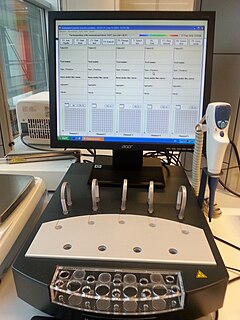 W
WThe Abbott AxSYM is an immunochemical automated analyzer made by Abbott Laboratories. It is used for serology tests and therapeutic drug monitoring, and uses antibodies to alter the deflection of polarized light. It can also be used to monitor hormone level and some cardiac markers such as troponin.
 W
WA blood lancet, or simply lancet, is a small medical implement used for capillary blood sampling. A blood lancet is similar to a small scalpel but with a double-edged blade or needle. Lancets are used to make punctures, such as a fingerstick, to obtain small blood specimens. Blood lancets are generally disposable.
 W
WBreath carbon monoxide is the level of carbon monoxide in a person's exhalation. It can be measured in a breath carbon monoxide test, generally by using a carbon monoxide breath monitor, such as for motivation and education for smoking cessation and also as a clinical aid in assessing carbon monoxide poisoning. The breath carbon monoxide level has been shown to have a close relationship with the level of CO in the blood known as carboxyhaemoglobin (%COHb) or "blood CO". This correlation allows for the level of CO in the blood to be indirectly measured through a breath sample.
 W
WThe Broselow Tape, also called the Broselow pediatric emergency tape, is a color-coded length-based tape measure that is used throughout the world for pediatric emergencies. The Broselow Tape relates a child's height as measured by the tape to his/her weight to provide medical instructions including medication dosages, the size of the equipment that should be used, and the level of shock voltage when using a defibrillator. Particular to children is the need to calculate all these therapies for each child individually. In an emergency the time required to do this detracts from valuable time needed to evaluate, initiate, and monitor patient treatment. The Broselow Tape is designed for children up to approximately 12 years of age who have a maximum weight of roughly 36 kg. The Broselow Tape is recognized in most medical textbooks and publications as a standard for the emergency treatment of children.
 W
WA catheterization laboratory, commonly referred to as a cath lab, is an examination room in a hospital or clinic with diagnostic imaging equipment used to visualize the arteries of the heart and the chambers of the heart and treat any stenosis or abnormality found.
 W
WA CO-oximeter is a device that measures the oxygen carrying state of hemoglobin in a blood specimen, including oxygen-carrying hemoglobin (O2Hb), non-oxygen-carrying but normal hemoglobin (HHb), as well as the dyshemoglobins such as carboxyhemoglobin (COHb) and methemoglobin (MetHb). The use of 'CO' rather than 'Co' or 'co' is more appropriate since this designation represents a device that measures carbon monoxide (CO) bound to hemoglobin, as distinguished from simple oximetry which measures hemoglobin bound to molecular oxygen—O2Hb—or hemoglobin capable of binding to molecular oxygen—HHb. Simpler oximeters may report oxygen saturation alone, i.e. the ratio of oxyhemoglobin to total 'bindable' hemoglobin. CO-oximetry is useful in defining the causes for hypoxemia, or hypoxia,.
 W
WA glucose meter, also referred to as a "glucometer", is a medical device for determining the approximate concentration of glucose in the blood. It can also be a strip of glucose paper dipped into a substance and measured to the glucose chart. It is a key element of home blood glucose monitoring (HBGM) by people with diabetes mellitus or hypoglycemia. A small drop of blood, obtained by pricking the skin with a lancet, is placed on a disposable test strip that the meter reads and uses to calculate the blood glucose level. The meter then displays the level in units of mg/dL or mmol/L.
 W
WA head mirror is a simple diagnostic device, stereotypically worn by physicians, but less so in recent decades as they have become somewhat obsolete.
 W
WA medical tricorder is a handheld portable scanning device to be used by consumers to self-diagnose medical conditions within seconds and take basic vital measurements. While the device is not yet on the mass market, there are numerous reports of other scientists and inventors also working to create such a device as well as improve it. A common view is that it will be a general-purpose tool similar in functionality to a Swiss Army Knife to take health measurements such as blood pressure and temperature, and blood flow in a noninvasive way. It would diagnose a person's state of health after analyzing the data, either as a standalone device or as a connection to medical databases via an Internet connection.
 W
WMultiplate multiple electrode aggregometry (MEA) is a test of platelet function in whole blood. The test can be used to diagnose platelet disorders, monitor antiplatelet therapy, and is also investigated as a potential predictor of transfusion requirements and bleeding risk in cardiac surgery.
 W
WA pneumograph, also known as a pneumatograph or spirograph, is a device for recording velocity and force of chest movements during respiration.
 W
WPulse oximetry is a noninvasive method for monitoring a person's oxygen saturation. Though its reading of peripheral oxygen saturation (SpO2) is not always identical to the more desirable reading of arterial oxygen saturation (SaO2) from arterial blood gas analysis, the two are correlated well enough that the safe, convenient, noninvasive, inexpensive pulse oximetry method is valuable for measuring oxygen saturation in clinical use.
 W
WA smart thermometer is a medical thermometer which is able to transmit its readings so that they can be collected, stored and analysed.
 W
WA spirometer is an apparatus for measuring the volume of air inspired and expired by the lungs. A spirometer measures ventilation, the movement of air into and out of the lungs. The spirogram will identify two different types of abnormal ventilation patterns, obstructive and restrictive. There are various types of spirometers that use a number of different methods for measurement.
 W
WThe stethoscope is an acoustic medical device for auscultation, or listening to internal sounds of an animal or human body. It typically has a small disc-shaped resonator that is placed against the skin, and one or two tubes connected to two earpieces. A stethoscope can be used to listen to the sounds made by the heart, lungs or intestines, as well as blood flow in arteries and veins. In combination with a manual sphygmomanometer, it is commonly used when measuring blood pressure.
 W
WThermoSensor is a coin-sized battery-powered RFID-enabled temperature sensor which is to be attached to the lower abdomen of patients by using 3M Tegaderm for body temperature monitoring. ThermoSensor was invented by the company Cadi Scientific in 2003 in Singapore for body temperature monitoring but it was later used for location tracking of patients too.